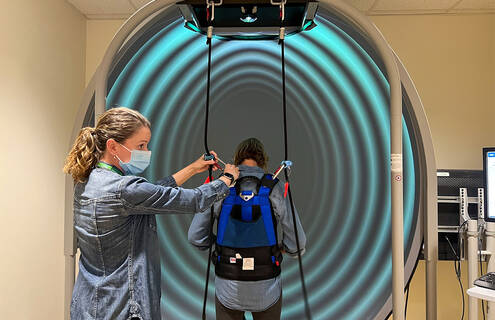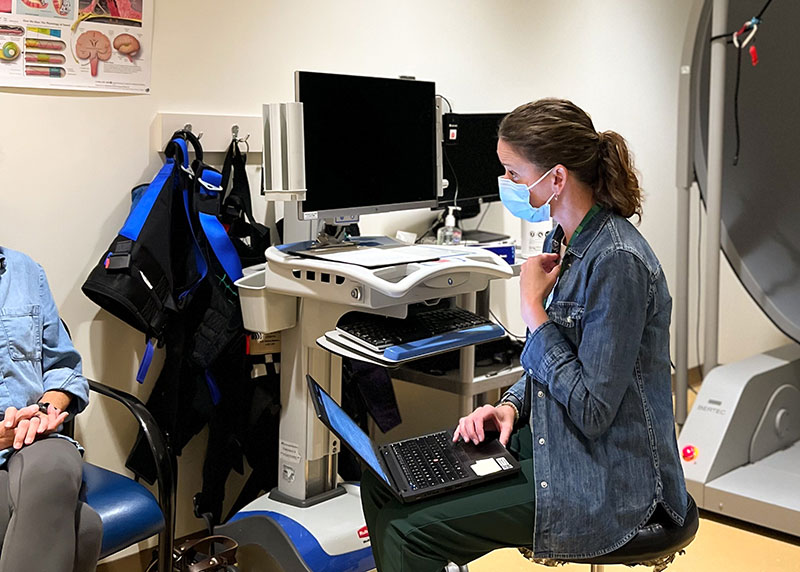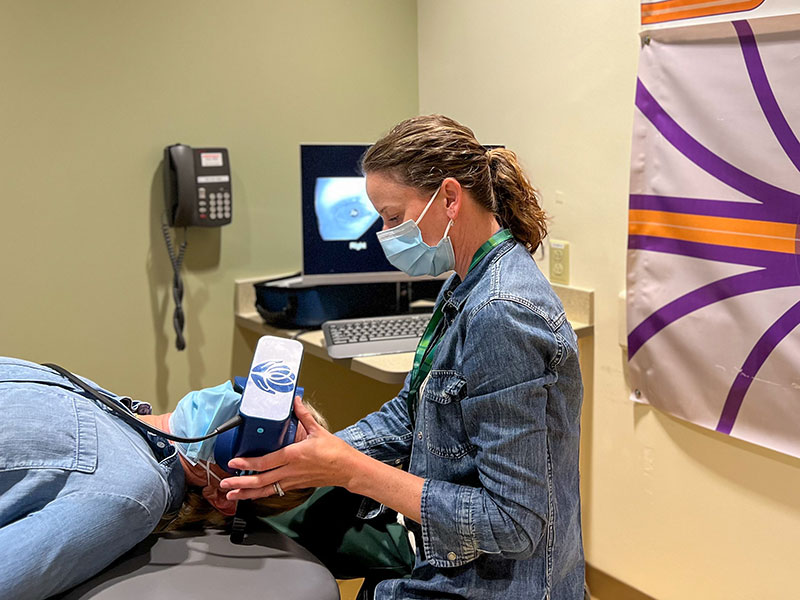
Linda Post is just shy of 75 years of age. She is lithe, fair, active, and fit, a seeming picture of good health. Three years ago, Post checked into a hospital with neuritis, an inflammation in the nervous system that in her case was triggered by an infection. With treatment, she recovered, mostly. She has not been able to resolve the dizziness that the infection seems to have triggered.
“It is extremely frustrating,” Post explains to Julia Noreika, PT, DPT, a physical therapist in Physical Medicine and Rehabilitation.
Post is not alone in her struggle
Dizziness is a common condition, particularly among women as they age.
Just how many people suffer is unclear, but a study reported by the NIH notes that dizziness and/or vertigo (the terms are often used interchangeably) affect between one-fifth and one-half of the population at some point in their lives. The condition is most common in people over fifty years old, with women in that age group over four times more likely to suffer.
“It’s a misconception that dizziness is normal as you age. It’s not,” Noreika says.
Identifying the cause of the condition and treating it effectively can prove challenging.
Her condition
For almost three years, Post has been trying to address her dizziness. She has consulted with doctors, physical therapists, and homeopathic providers around the world. A cataract operation seems to have addressed her light sensitivity, but she still gets the occasional migraine. She practices Pilates regularly and works to maintain her fitness. She does eye and neck exercises. Despite all the recommendations and treatments, the dizziness persists.
“It has lessened, but it just does not go away,” says Post.
The risks of dizziness
Dizziness can be debilitating and affect one’s ability to function. It is among the most common reasons for medical consultation and accounts for two to three percent of total consultations in emergency departments.
Nearly 26 million people in the United States needed to visit an emergency department for dizziness and vertigo over a period of 10 years (1995-2004).
Among the associated risks is a greater propensity to fall, which is the second leading cause of death worldwide.
Fortunately for Post, her balance is okay. She has found ways to compensate. She can stand on one foot, eyes closed. But, given she has osteoporosis, she is concerned that she is at increased risk for a fall, particularly as she ages.
Getting to the root of dizziness
There are three systems that affect our balance. These are vestibular, somatosensory (which is the perception of touch pressure, pain, temperature, position, movement and vibration), and vision. Together with the cochlea, the vestibular system is what constitutes the inner ear, contributing to our sense of balance and spatial orientation. Of the three systems, the vestibular is most closely associated with dizziness. Because most causes of Post’s dizziness have been ruled out through past consultations with other specialists, Post is seeing Noreika about her vestibular system.
Testing for dizziness
Noreika begins her consultation by posing a number of questions. She asks Post to describe her symptoms, how the dizziness makes her feel, what triggers it, and how long it lasts.

Post explains to Noreika that her dizziness worsens when she moves her head horizontally or looks up from a computer. Sometimes, when she wakes up, she has stiffness in her neck.
Noreika records the information, asks a few more questions, and proceeds to conduct a series of tests.
First, Noreika tests Post’s eye movement to determine if something is wrong within the brain, brainstem, or cerebellum. She has Post focus on the tip of a pen and later, on the back of a wall. She watches how Post’s eyes respond.
Next, Noreika asks Post to put on goggles to test if she has benign paroxysmal positional vertigo (BPPV).

BPPV is caused by a mass of crystals in the ear canals, causing the fluid in our ears to move differently, triggering dizziness. If she has the condition, Post will show abnormal eye movement when she moves her head. She does not.
Finally, Post steps into what resembles a giant umbrella turned on its side. She puts on a harness with cords rising from her shoulders, as if she were hanging from a parachute. The machine is called a Bertec and tests all three systems of balance.
“It is very stressful,” says Post, who has been tested with a Bertec before. “You have no horizontal or vertical lines to tell you where you are in space."
Results show that her ability to balance is above her age and gender cohort in all areas.
So what is Post’s diagnosis?
“The final diagnosis is an uncompensated unilateral vestibular hypofunction,” says Noreika, who believes that the neuritis from several years ago decreased the function of Post’s vestibular nerve on one side. Normally, she says, the body can compensate and adjust to some degree. But in Linda’s case, the brain did not and her previous therapy also did not give her the proper frequency and intensity guidelines for performing her exercises.
To address her condition, Noreika recommends that Post do vestibular exercises three to five times throughout the day for a total of up to 40 minutes. These gaze stabilization exercises work to fine-tune the reflex between the vestibular system and the eyes because when this vestibular-ocular reflex is not working properly, the brain receives a mismatch of information, which is experienced as dizziness.
And it is not just gaze stabilization exercises that will help Post. Noreika says she also will benefit from incorporating static and dynamic balance and coordination exercises.
Results will not be immediate and Noreika believes that with added knowledge and the appropriate exercises, the condition will improve.
If you are experiencing dizziness
Dizziness may be from an inner ear disorder, a medical condition, or other issues such as anxiety, dehydration, low blood sugar, medications, motion sickness and even carbon monoxide poisoning. To address it, first try to get to the cause. Talk to your provider if you are concerned.
You should seek immediate medical attention if you feel dizzy and also have other symptoms. These may include:
- pain, pressure, heaviness or tightness in the chest, shoulders, neck, arms, jaw, or back
- shortness of breath
- nausea or cold sweats
- numbness or weakness in your face, arm or leg
- trouble talking, understanding or swallowing
- vision issues
- confusion
If you do have persistent dizziness, seek help. Causes, prognoses, and treatments differ. As Post has discovered, getting to the root and addressing the issue can take time.
Concludes Noreika: "A lot of people come to us having seen other providers and worry they'll live with their dizziness indefinitely. The best part of my job is when people have almost given up hope and, through treatment, realize they can take control and improve their dizziness."